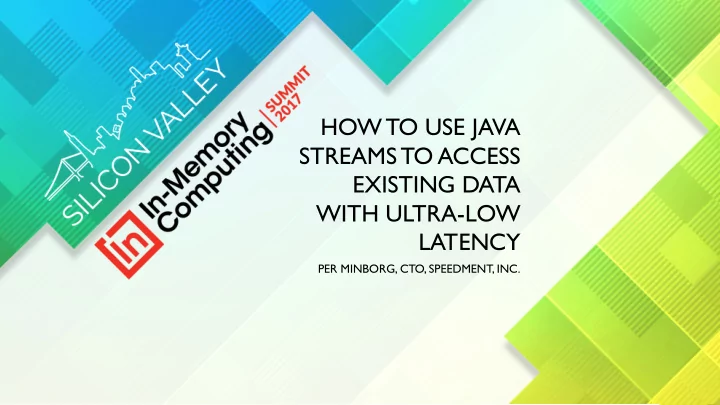

HOW TO USE JAVA STREAMS TO ACCESS EXISTING DATA WITH ULTRA-LOW LATENCY PER MINBORG, CTO, SPEEDMENT, INC.
WHO AM I? Serial Entrepreneur ¡ +15 US Patents ¡ Java Expert ¡ Palo Alto ¡ Minborg’s Java Pot ¡
TITLE OF SLIDE GOES HERE
SPEED INVERTED
WHY ARE DELAYS A PROBLEM? Bad User Experience ¡ 100 ms : direct response ¡ 1 second: experienced a delay ¡ 3 seconds: becomes frustrated, 57% leave the site ¡ 10 seconds: 100% tired ¡
WHY ARE DELAYS A PROBLEM? 100 ms 1 s 3 s 10 s
WHY ARE DELAYS A PROBLEM? Less Page Views Google lost 20% traffic with half a second delay ¡ Less Revenue Amazon lost 1% of sales for every 100 ms delay ¡ Higher Overhead Unnecessary hardware and license cost ¡ Destroys the Brand 44% worry when paying transactions take too long ¡
WHAT IF THE PROBLEM IS SCALED BY ONE MILLION?
OTHER AREAS WHERE SPEED MATTERS Fintech and High Frequency Trading ¡ AI ¡ IoT ¡ Defense, Intelligence and Situation Awareness ¡ Logistics ¡ Science Applications (e.g. Space, DNA) ¡ Microservice Architecture ¡ General Computing ¡
REQUIREMENTS Low-latency ¡ Deterministic behavior ¡ Low memory footprint ¡ Low CPU utilization ¡ Low memory pressure ¡ Parallelism ¡ Scale out capability ¡ … ¡
TARGET
LATENCY REQUIREMENT BREAK-DOWN It all adds up… ¡ L tot = ∑ L n with maybe millions of steps in less than perhaps one second ¡ We need operations that can complete well into the nanoseconds (~200 ns) ¡
WHAT ABOUT CLUSTERS OF NODES? SF - NY speed of light latency is > 15 ms * 2 * (3/2) > 45 ms for fiber ¡ TCP roundtrip latency with two Linux hosts connected directly with 10Gb/s Ethernet ¡ Some tweaks 40 us ¡ Busy polling and CPU affinity 30 us ¡ Expert mode ~25 us ¡ Routers and switches introduce significant additional delays ¡ AWS, Google Cloud, Bluemix etc. introduces significant additional network delays even on co-located servers ¡
HOW ABOUT DIFFERENT PROCESSES ON THE SAME MACHINE? Inter-Process Communication is in the milliseconds ¡ Context Switch -> L1, L2, L3 + TLB affected ¡
WITHIN THE JVM ITSELF Main Memory Read ~100 ns ¡ Volatile read ¡ L3 ~20ns ¡ L2 ~7ns ¡ L1 ~0.5ns ¡ CPU Registers ¡
MICROSERVICE ARCITECTURE APPLICATION
MULTI-CORE INTEL CPU
UNDERSTANDING HARDWARE
UNDERSTANDING HARDWARE
CONCLUSION: IN-JVM-MEMORY
API – STANDARD JAVA STREAM
COMPARISON BETWEEN SQL AND STREAM OPERATIONS SQL Java Stream Operations(s) FROM stream() SELECT map() WHERE filter() (before collecting) HAVING filter() (after collecting) JOIN flatmap() or map() DISTINCT distinct() UNION concat(s0, s1).distinct() ORDER BY sorted() OFFSET skip() LIMIT limit() GROUP BY collect(groupingBy()) COUNT count()
DECLARATIVE CONSTRUCTS IN BOTH SQL AND STREAM SELECT * FROM FILM WHERE RATING = ’PG-13’ films.stream() .filter(Film.RATING.equal(Rating.PG13))
SPEEDMENT 1. Java stream ORM-tool 2. In-JVM Memory &
MARKET POSITION Speed ns us ms s min hour days GB TB EB
JAVA 9 DEMO
THE SOLUTION In-JVM-Memory Access with a Java Stream API ¡ Streams introspect their own pipeline ¡ Off-Heap storage ¡ MVCC immutable snapshots ¡ Light weighted Off-Heap indexing ¡ O(1) and O(log(N)) operations ¡ Collectors that do not create intermediate objects ¡ Aggregators that do not create intermediate objects ¡ Snapshot compression/folding ¡ Stack allocation of objects instead of heap allocation ¡
COLLECTOR WITHOUT INTERMEDIATE OBJECTS films.stream() .filter(Film.RATING.equal(Rating.PG13)) .collect(toJsonLengthAndTitle())); index film_id length rating year language title [0] 0 267 267 0 0 0 [1] 267 0 0 267 267 267 [2] 523 523 523 523 523 523 index film_id length rating year language Title 0 4 12 16 20 … [0] 1 123 PG-13 2006 1 ACAD.. [267] 2 69 G 2006 1 ACE G… [523] 3 134 PG-13 2006 1 ADAP…
SCALING OUT – MULTIPLE NODES User Space Kernel Space Disk blocks Microservice1 JVM 2 Microservice1 JVM 1 Filesystem mapped buffer Page cache Page mapping mapped buffer filesystem pages SSD Physical memory memory pages
SCALING OUT - SHARDING
WHY IS SPEED IMPORTANT? Off-Heap in-JVM- Objects in-memory memory Average latency [ms] 105 1,100 99.5% percentile [ms] 160 ~7,000 Nodes 2 8 Major GCs 0 27 Total RAM [GB] 128 2,048 Total CPUs 4 64 Average CPU utilization 40% 2,100% Initial ingestion time 2 28 [min] Operating cost $ $$$ User experience +++ +
THE DIFFERENCE During the time a database makes a one second query, how far will the light move? Database CPU L1 cache Conclusion : Do not place your data on the moon, keep it close by using in-JVM-memory technology!
INTEGRATES WITH ANY DATA SOURCE
DEPLOY ANYWHERE
IDE INTEGRATION
INTEGRATION
APPLICATION API
STEPWISE INTRODUCTION
TRY IT!
TRY IT!
THANK YOU! minborg@speedment.com ¡ Mention IMCS to get ¡ 30 min free consultation (Nov) Calendly.com/speedment ¡
INTEGRATION
Recommend
More recommend